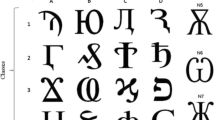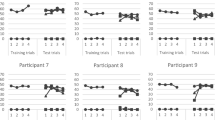Abstract
Extinction of a response in the presence of one stimulus in an equivalence class can transfer to other related stimuli, but difficulties in establishing extinction can compromise analyses. The present study evaluated the transfer of avoidance extinction with two extinction procedures. In particular, avoidance or nonavoidance was always (Experiment 1) and never (Experiment 2) followed by point loss in the crucial extinction test phase. Both experiments began with the establishment of two equivalence classes with four abstract figures in each (A1-B1-C1-D1 and A2-B2-C2-D2). Clicking a button to avoid loss of points was trained with B1 and subsequently observed without direct training in the presence of C1 and D1. Extinction was then conducted with one group of participants with stimuli that underwent avoidance training (direct extinction with B1 and B2) and with another group with stimuli who did not undergo avoidance training (derived extinction with C1 and C2). Finally, the transfer of extinction was evaluated with stimuli from both classes. In Experiment 1, 10 of 14 participants met the avoidance extinction criteria, and the transfer of extinction occurred for 2 (1 in the direct and 1 in the derived extinction group). In Experiment 2, 10 of 13 participants met the avoidance extinction criteria, and the transfer of extinction occurred for 6 (5 in the direct and 1 in the derived extinction group). Overall, the transfer of extinction occurred only with the combination of an extinction procedure without aversive events and direct extinction.




Similar content being viewed by others
Data availability
Additional data may be provided upon request to the corresponding author.
References
Assaz, D. A., Roche, B., Kanter, J. W., & Oshiro, C. K. B. (2018). Cognitive defusion in acceptance and commitment therapy: What are the basic processes of change? Psychological Record, 68(4), 405–418. https://doi.org/10.1007/s40732-017-0254-z
Augustson, E. M., & Dougher, M. J. (1997). The transfer of avoidance evoking functions through stimulus equivalence classes. Journal of Behavior Therapy & Experimental Psychiatry, 28(3), 181–191. https://doi.org/10.1016/S0005-7916(97)00008-6
Barnes-Holmes, D., Barnes-Holmes, Y., & McEnteggart, C. (2020). Updating RFT (more field than frame) and its implications for process-based therapy. The Psychological Record, 70(4), 605–624. https://doi.org/10.1007/s40732-019-00372-3
Boldrin, L. S., Assaz, D. A., & Debert, P. (2020). Estudos de pesquisa básica sobre transferência de extinção e suas implicações para as terapias baseadas em exposição. Acta Comportamentalia, 28(2), 205–221. http://www.revistas.unam.mx/index.php/acom/article/view/75951
Boldrin, L. S., & Debert, P. (2020). Direct and derived extinction of avoidance responses in equivalence classes. Psychological Record, 70(3), 433–444. https://doi.org/10.1007/s40732-020-00419-w
Boldrin, L. S., & Debert, P. (2022a). Behavior lab software (Version 1.0)[Computer Software]. Instituto de Psicologia da Universidade de São Paulo.
Boldrin, L. S., & Debert, P. (2022b). Matching to sample procedure software (Versão 2.0) [Computer Software]. Instituto de Psicologia da Universidade de São Paulo.
Bouton, M. E., & Bolles, R. C. (1979). Contextual control of the extinction of conditioned fear. Learning & Motivation, 10(4), 445–466. https://doi.org/10.1016/0023-9690(79)90057-2
Cameron, G., Zuj, D. V., Dymond, S., & Quigley, M. (2022). Remote, online assessment of avoidance learning. Learning & Motivation, 78, 101805. https://doi.org/10.1016/j.lmot.2022.101805
Carrigan, P. F., & Sidman, M. (1992). Conditional discrimination and equivalence relations: A theoretical analysis of control by negative stimuli. Journal of the Experimental Analysis of Behavior, 58(1), 183–204. https://doi.org/10.1901/jeab.1992.58-183
Crosbie, J. (1998). Negative reinforcement and punishment. In K. A. Lattal & M. Perone (Eds.), Handbook of research methods in human operant behavior (pp. 163–189). Springer. https://doi.org/10.1007/978-1-4899-1947-2_6
de Rose, J. C., McIlvane, W. J., Dube, W. V., Galpin, V. C., & Stoddard, L. T. (1988). Emergent simple discrimination established by indirect relation to differential consequences. Journal of the Experimental Analysis of Behavior, 50(1), 1–20. https://doi.org/10.1901/jeab.1988.50-1
Dougher, M. J., Augustson, E., Markham, M. R., Greenway, D. E., & Wulfert, E. (1994). The transfer of respondent eliciting and extinction functions through stimulus equivalence classes. Journal of the Experimental Analysis of Behavior, 62(3), 331–351. https://doi.org/10.1901/jeab.1994.62-331
Dymond, S. (2019). Overcoming avoidance in anxiety disorders: The contributions of Pavlovian and operant avoidance extinction methods. Neuroscience & Biobehavioral Reviews, 98, 61–70. https://doi.org/10.1016/J.NEUBIOREV.2019.01.007
Dymond, S., Bennett, M., Boyle, S., Roche, B., & Schlund, M. (2018). Related to anxiety: Arbitrarily applicable relational responding and experimental psychopathology research on fear and avoidance. Perspectives on Behavior Science, 41(1), 189–213. https://doi.org/10.1007/s40614-017-0133-6
Dymond, S., Dunsmoor, J. E., Vervliet, B., Roche, B., & Hermans, D. (2015). Fear generalization in humans: Systematic review and implications for anxiety disorder research. Behavior Therapy, 46(5), 561–582. https://doi.org/10.1016/j.beth.2014.10.001
Dymond, S., Roche, B., Forsyth, J. P., Whelan, R., & Rhoden, J. (2008). Derived avoidance learning: Transformation of avoidance response functions in accordance with the relational frames of same and opposite. The Psychological Record, 58, 271–288. https://doi.org/10.1007/BF03395615
Dymond, S., Roche, B., Forsyth, J., Whelan, R., & Rhoden, J. (2007). Transformation of avoidance response functions in accordance with same and opposite relational frames. Journal of the Experimental Analysis of Behavior, 88(2), 249–262. https://doi.org/10.1901/jeab.2007.88-249
Dymond, S., Schlund, M. W., Roche, B., Whelan, R., Richards, J., & Davies, C. (2011). Inferred threat and safety: Symbolic generalization of human avoidance learning. Behaviour Research & Therapy, 49(10), 614–621. https://doi.org/10.1016/J.BRAT.2011.06.007
Ferster, C. B. (1953). The use of the free operant in the analysis of behavior. Psychological Bulletin, 50(4), 263–274. https://doi.org/10.1037/h0055514
Galizio, M. (1979). Contingency-shaped and rule-governed behavior: Instructional control of human loss avoidance. Journal of the Experimental Analysis of Behavior, 31(1), 53–70. https://doi.org/10.1901/jeab.1979.31-53
Gandarela, L., Boldrin, L. S., & Debert, P. (2020). Transfer of the avoidance function in equivalence classes using loss of points as the aversive stimulus. The Psychological Record, 70(3), 471–479. https://doi.org/10.1007/S40732-019-00365-2
Garcia-Guerrero, S., Dickins, T. E., & Dickins, D. W. (2014). The gradual extinction of transferred avoidance stimulus functions. The Psychological Record, 64(3), 581–599. https://doi.org/10.1007/s40732-014-0062-7
Guinther, P. M., & Dougher, M. J. (2015). The clinical relevance of stimulus equivalence and relational frame theory in influencing the behavior of verbally competent adults. Current Opinion in Psychology, 2, 21–25. https://doi.org/10.1016/J.COPSYC.2015.01.015
Hayes, S. C., Barnes-Holmes, D., & Roche, B. T. (2001). Relational frame theory: A post-Skinnerian account of human language and cognition. Plenum Press.
Lattal, K. A., St. Peter, C., & Escobar, R. (2013). Operant extinction: Elimination and generation of behavior. APA handbook of behavior analysis: Translating principles into practice (2nd ed., pp. 77–107). American Psychological Association. https://doi.org/10.1037/13938-004
Lonsdorf, T. B., Menz, M. M., Andreatta, M., Fullana, M. A., Golkar, A., Haaker, J., Heitland, I., Hermann, A., Kuhn, M., Kruse, O., Drexler, M. S., Meulders, A., Nees, F., Pittig, A., Richter, J., Römer, S., Shiban, Y., Schmitz, A., Straube, B., ..., Merz, C. J. (2017). Don’t fear “fear conditioning”: Methodological considerations for the design and analysis of studies on human fear acquisition, extinction, and return of fear. Neuroscience & Biobehavioral Reviews, 77, 247–285. https://doi.org/10.1016/j.neubiorev.2017.02.026
Lonsdorf, T. B., Merz, C. J., & Fullana, M. A. (2019). Fear extinction retention: Is it what we think it is? Biological Psychiatry, 85(12), 1074–1082. https://doi.org/10.1016/j.biopsych.2019.02.011
Luciano, C., Valdivia-Salas, S., Ruiz, F. J., Rodríguez-Valverde, M., Barnes-Holmes, D., Dougher, M. J., Cabello, F., Sánchez, V., Barnes-Holmes, Y., & Gutierrez, O. (2013). Extinction of aversive eliciting functions as an analog of exposure to conditioned fear: Does it alter avoidance responding? Journal of Contextual Behavioral Science, 2(3–4), 120–134. https://doi.org/10.1016/j.jcbs.2013.05.001
Markham, M. R., Dougher, M. J., & Augustson, E. M. (2002). Transfer of operant discrimination and respondent elicitation via emergent relations of compound stimuli. The Psychological Record, 52(3), 325–350. https://doi.org/10.1007/BF03395434
Perez, W. F., de Almeida, J. H., Soares, L. C. C. S., Wang, T. F. L., de Morais, T. E. D. G., Mascarenhas, A. V., & de Rose, J. C. (2020). Fearful faces and the derived transfer of aversive functions. Psychological Record, 70(3), 387–396. https://doi.org/10.1007/s40732-020-00390-6
Perone, M. (1991). Experimental design in the analysis of free-operant behavior. Experimental Analysis of Behavior, Parts 1 & 2 (pp. 135–171). Elsevier Science.
Roche, B. T., Kanter, J. W., Brown, K. R., Dymond, S., & Fogarty, C. C. (2008). A comparison of “direct” versus “derived” extinction of avoidance responding. The Psychological Record, 58(3), 443–464. https://doi.org/10.1007/BF03395628
Sidman, M. (1994). Equivalence relations and behavior: A research story. Authors Cooperative.
Valverde, M. R., Luciano, C., & Barnes-Holmes, D. (2009). Transfer of aversive respondent elicitation in accordance with equivalence relations. Journal of the Experimental Analysis of Behavior, 92(1), 85–111. https://doi.org/10.1901/jeab.2009.92-85
Vervoort, E., Vervliet, B., Bennett, M., & Baeyens, F. (2014). Generalization of human fear acquisition and extinction within a novel arbitrary stimulus category. PLOS ONE, 9(5), e96569. https://doi.org/10.1371/JOURNAL.PONE.0096569
Funding
LSB was supported by the National Council for Scientific and Technological Development (CNPq, grant #149766/2018-1) and the Coordination of Superior Level Staff Improvement (CAPES, grant #88887.750009/2022-00). This research is part of the scientific program of the National Institute of Science and Technology on Behavior, Cognition, and Teaching (INCT-ECCE), supported by the National Council for Scientific and Technological Development (CNPq, grant #465686/2014-1) and the São Paulo Research Foundation (FAPESP, grant #2014/50909-8).
Author information
Authors and Affiliations
Contributions
LSB and PD conceived the study. LSB prepared the material and collected the data. LSB and PD analyzed the data. All authors (LSB, PD, and SD) discussed the data and contributed to the writing of the article.
Corresponding author
Ethics declarations
Human Ethics
The study was approved by the Human Research Ethics Committee of the Institute of Psychology of the University of São Paulo (process #29904920.1.0000.5561). All the procedures performed in the studies involving human participants were in accordance with the ethical standards of the institutional and/or national research committee, and with the 1964 Helsinki Declaration and its later amendments or comparable ethical standards.
Consent to participate
Informed consent was obtained from all individual participants included in the study.
Conflict of interest
On behalf of all authors, the corresponding author states that there is no conflict of interest.
Additional information
Publisher's Note
Springer Nature remains neutral with regard to jurisdictional claims in published maps and institutional affiliations.
Rights and permissions
Springer Nature or its licensor (e.g. a society or other partner) holds exclusive rights to this article under a publishing agreement with the author(s) or other rightsholder(s); author self-archiving of the accepted manuscript version of this article is solely governed by the terms of such publishing agreement and applicable law.
About this article
Cite this article
Boldrin, L.S., Debert, P. & Dymond, S. Avoidance Extinction in Equivalence Classes. Psychol Rec 74, 1–16 (2024). https://doi.org/10.1007/s40732-023-00580-y
Accepted:
Published:
Issue Date:
DOI: https://doi.org/10.1007/s40732-023-00580-y




